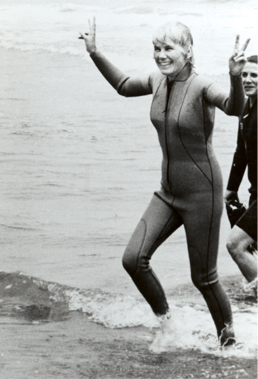As Republican hopefuls walk the runway for the 2012 race, and as we near the November mid-terms, it’s clear that we’ll still be wanting for new ideas. The “Pledge to America” is an unspecific sound-bite that’s good electioneering and little else. Many Democrats, if they vote at all, will perceive Obama as a middle-of-the road conservative. Again, we seem to have few choices to vote for, and only a few better choices to vote against.
What would happen if we stopped relying on politicians, business people and lawyers to populate our elective posts? What if – imagine! – an artist sought the highest office in the land?
That’s what Susanna Dakin tested in 1984, and has now recounted in her memoir of that campaign, An Artist for President. Dakin, as a performance artist, grasped as well as Ronald Reagan that image is reality, but, unlike Reagan, set out on her campaign to ask her audiences to question themselves about what this means for America. So she began in Southern California, emerging from the sea like a wet-suited, short-haired Venus, and held her first press conference on Venice Beach.
“Ultimately, if all citizens of this country make the effort to become artists… in due course we will have an artist for President,” she declared. “Of course, for that to happen, we the people need to know that art actually has the power to transform the world we live in.”
From LA, the nation’s center of performance art at that time, Dakin began a nationwide campaign tour. She got novelty press coverage along the way, and her cross country travels ran the gamut of highs and lows – when she arrived at New Orleans, it was hard not to appreciate the city as a tourist, and she almost forgot her “political” duties; at another moment, a somber moment, she suspended her campaign when a key supporter was violently raped and beaten. The latter event moved Dakin to view her campaign more in terms of “the relationship between performance art, politics and spirituality,” and what social change might occur if a woman actually became President.
Geraldine Ferraro was nominated as the Vice Presidential candidate at the Democratic convention that year, and in watching that event Dakin felt some small measure of what such change might feel like.
At the heart of Dakin’s unselfconscious and effortlessly-written memoir is this question: What role might artists play in the greater social fabric of our lives, and how could that change America?
An Artist for President will be published September 30.

